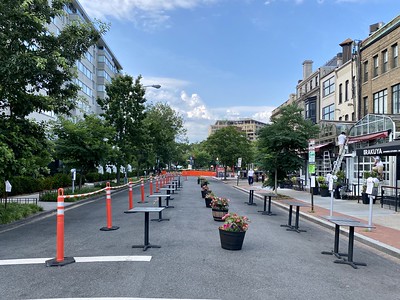Revisiting pedestrianizing the 1500 block of 19th Street NW in Dupont Circle
Recently, the entry "" discusses how to make pedestrian and bicycling right of way expansions in the wake of the coronavirus a more permanent condition.
In 2019, the entry "Planning urban design improvements at the neighborhood scale: Dupont Circle, DC," discusses a systematic program for urban design improvements in and around Dupont Circle. It was an outgrowth of my Purple Line series-thinking, although it took me a couple years to get around to writing about it.
One of the recommendations, Item #5, was pedestrianizing the 1500 block of 19th Street NW, which is the block with the Dupont Plaza Hotel on the east and the block of businesses on Connecticut--many have rear entrances, anchored by Kramerbooks and Afterwords Cafe, the combined bookstore-cafe that is open 24 hours on weekends (in normal times) and a very busy Starbucks.
5. Make 19th St. between the Circle and Q Street a permanent pedestrian street (but with access for deliveries.)
Joe Flood, via Flickr, shares with us his photo of this block, set up for expanded restaurant patio service.

I made a similar recommendation, starting with weekends, for 17th Street:
6. Make 17th Street between P and R Streets a pedestrian district on weekends.

And from an update standpoint, instead DDOT and the Washington Area Bicyclists Association, is pushing the addition of a cycletrack to 17th Street, which would get in the way of pedestrianizing it.
Given the pedestrian volume in the area, and the need for this commercial street section to have a positioning that is more distinct vis a vis neighboring 14th Street and Dupont Circle as a way for its establishments to be more competitive, emphasizing and strengthening its pedestrian character should be prioritized over cycling--especially given nearby parallel routes, and let's face it, relatively low volumes of bicyclists.
In the past I've suggested that WABA reposition from a cyclist-exclusive orientation to a more expansive "sustainable mobility" agenda like Transportation Alternatives in NYC and Active Transportation Alliance in Chicago (formerly the Chicago Bicyclists Federation), they haven't done so.
So there isn't a good pedestrian advocacy group in the city--robust examples elsewhere include Feet First in Seattle, Starkville in Motion in Mississippi (although they do biking too), Walk Boston and Walk Denver--and therefore in DC the pedestrian agenda can too often be neglected.
Labels: bicycle and pedestrian planning, integrated public realm framework, neighborhood planning, pedestrian malls, pedestrian planning, sidewalks, urban design/placemaking, walking



0 Comments:
Post a Comment
<< Home